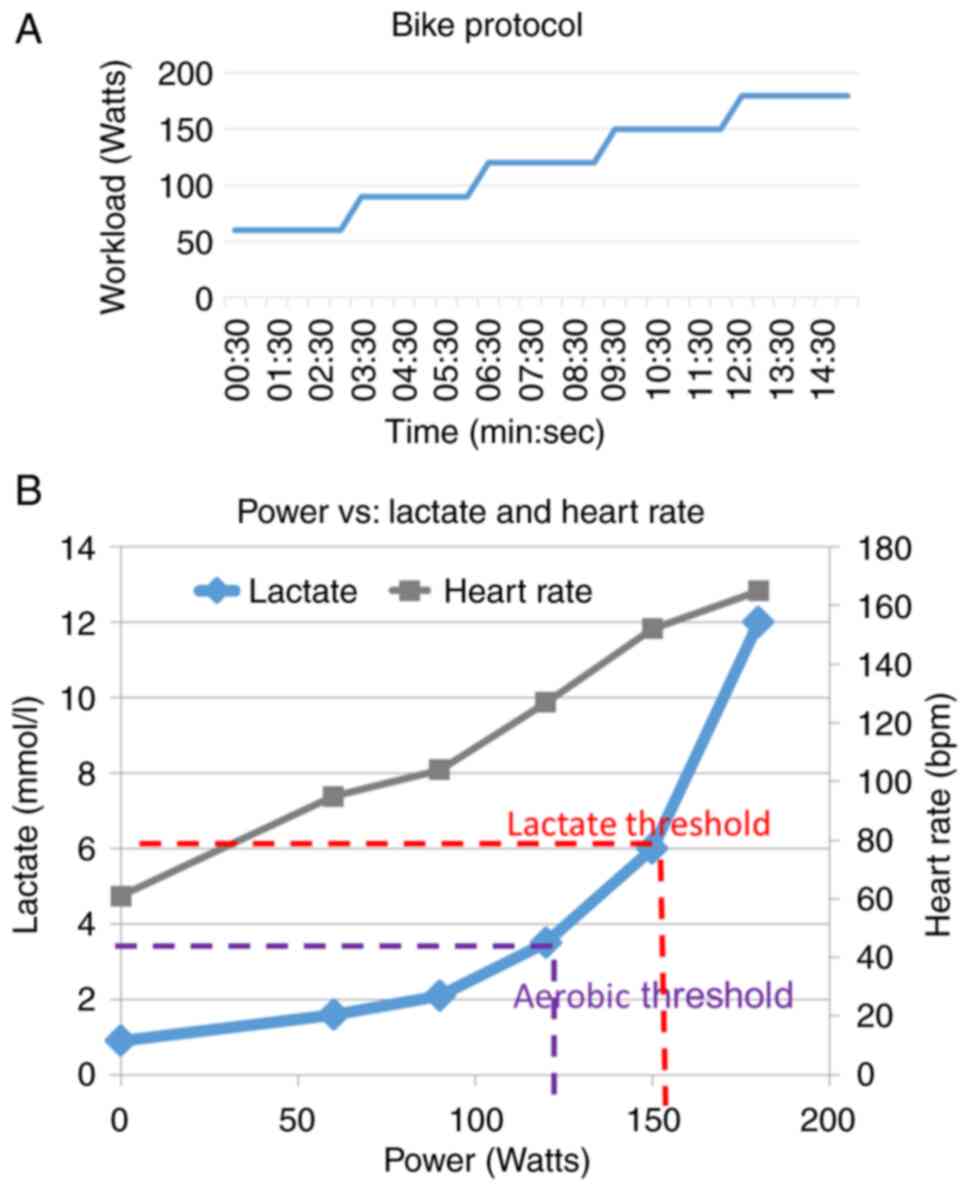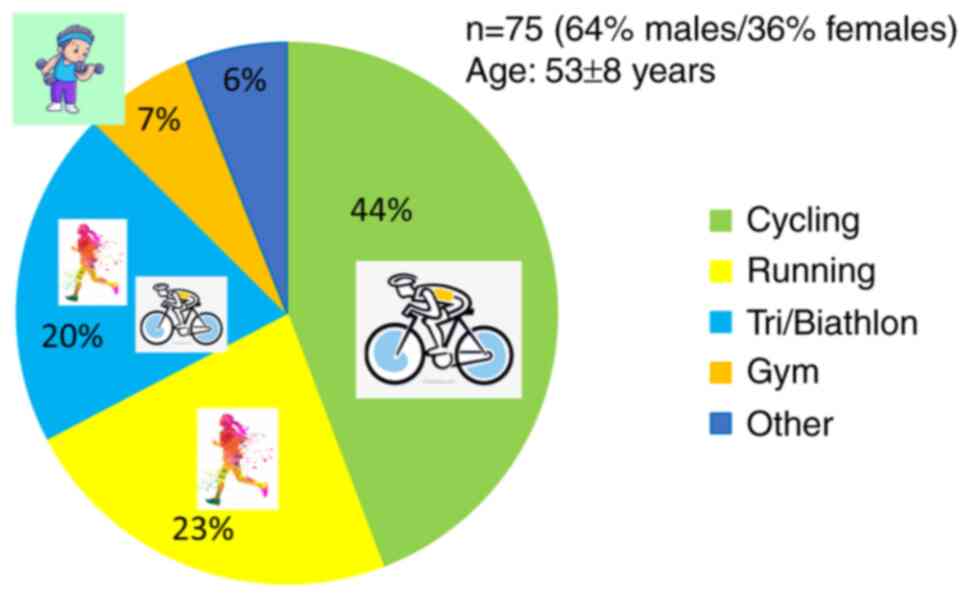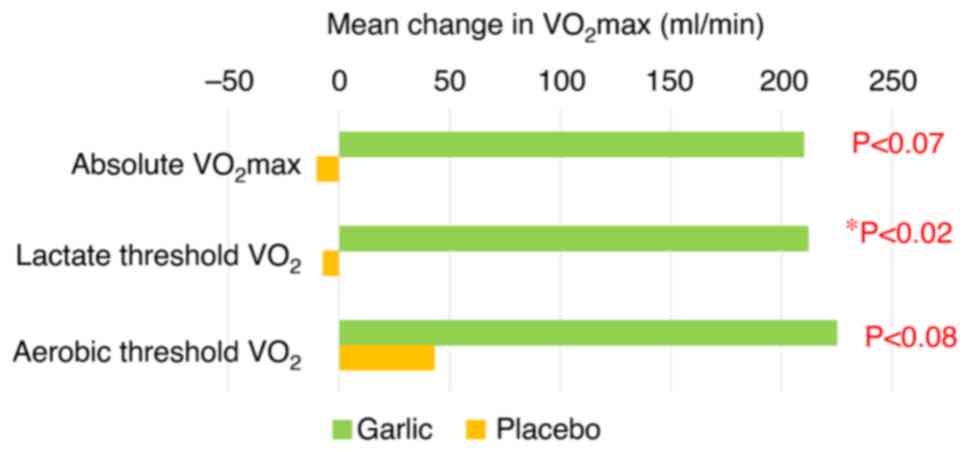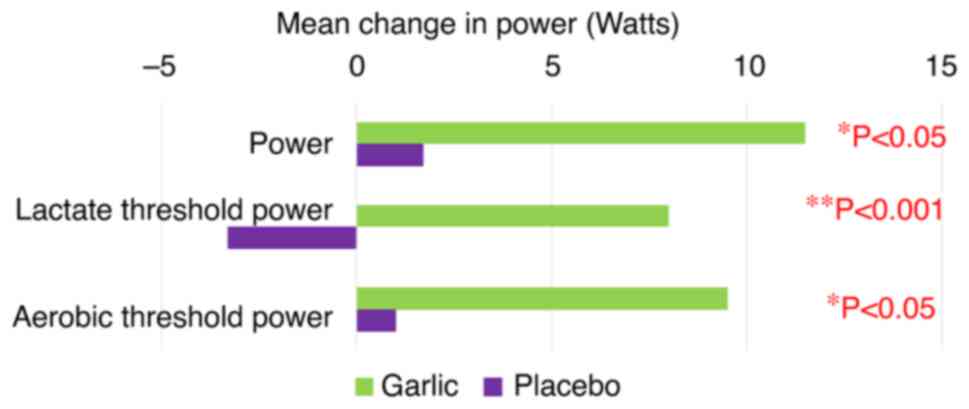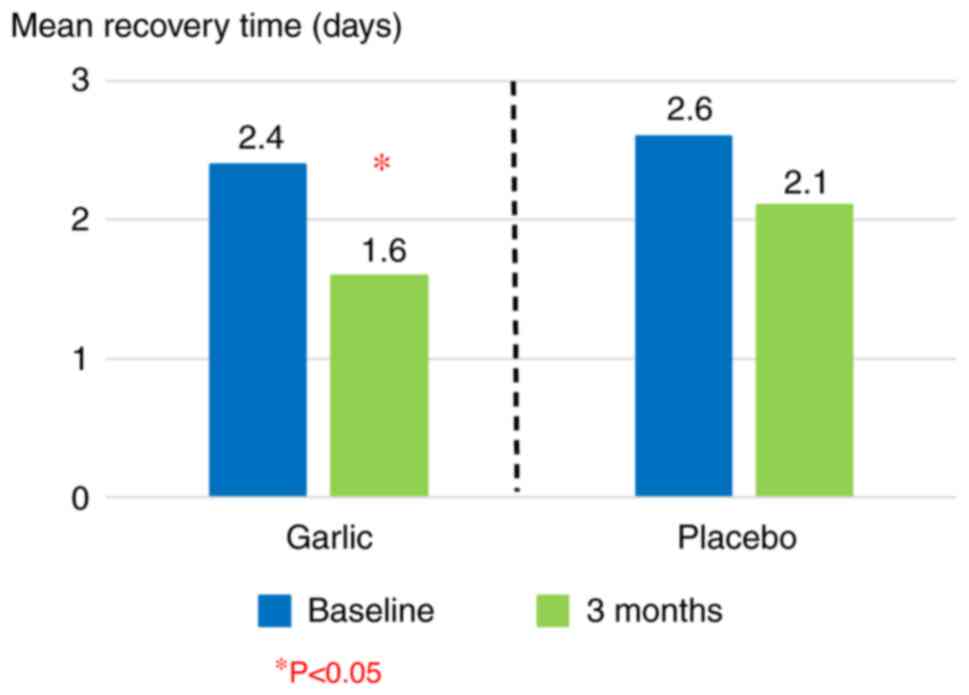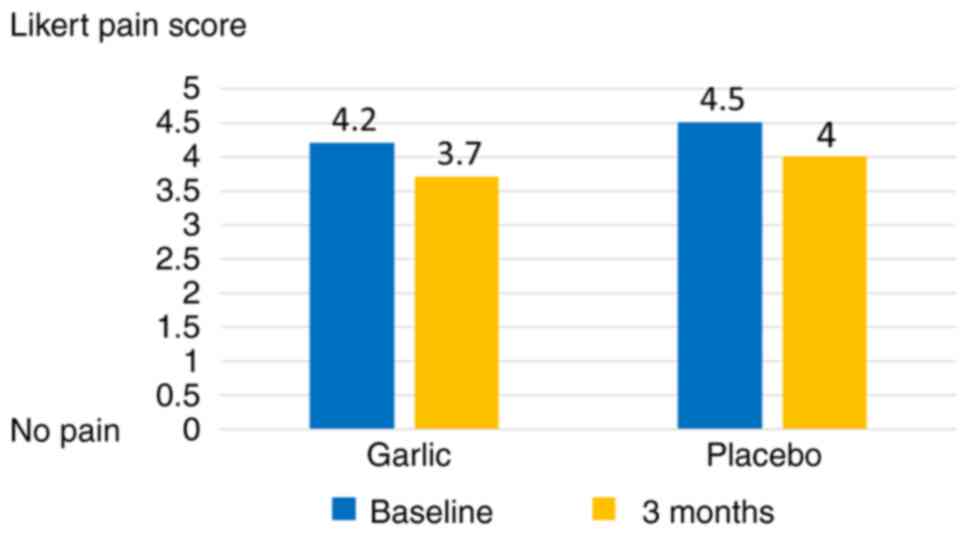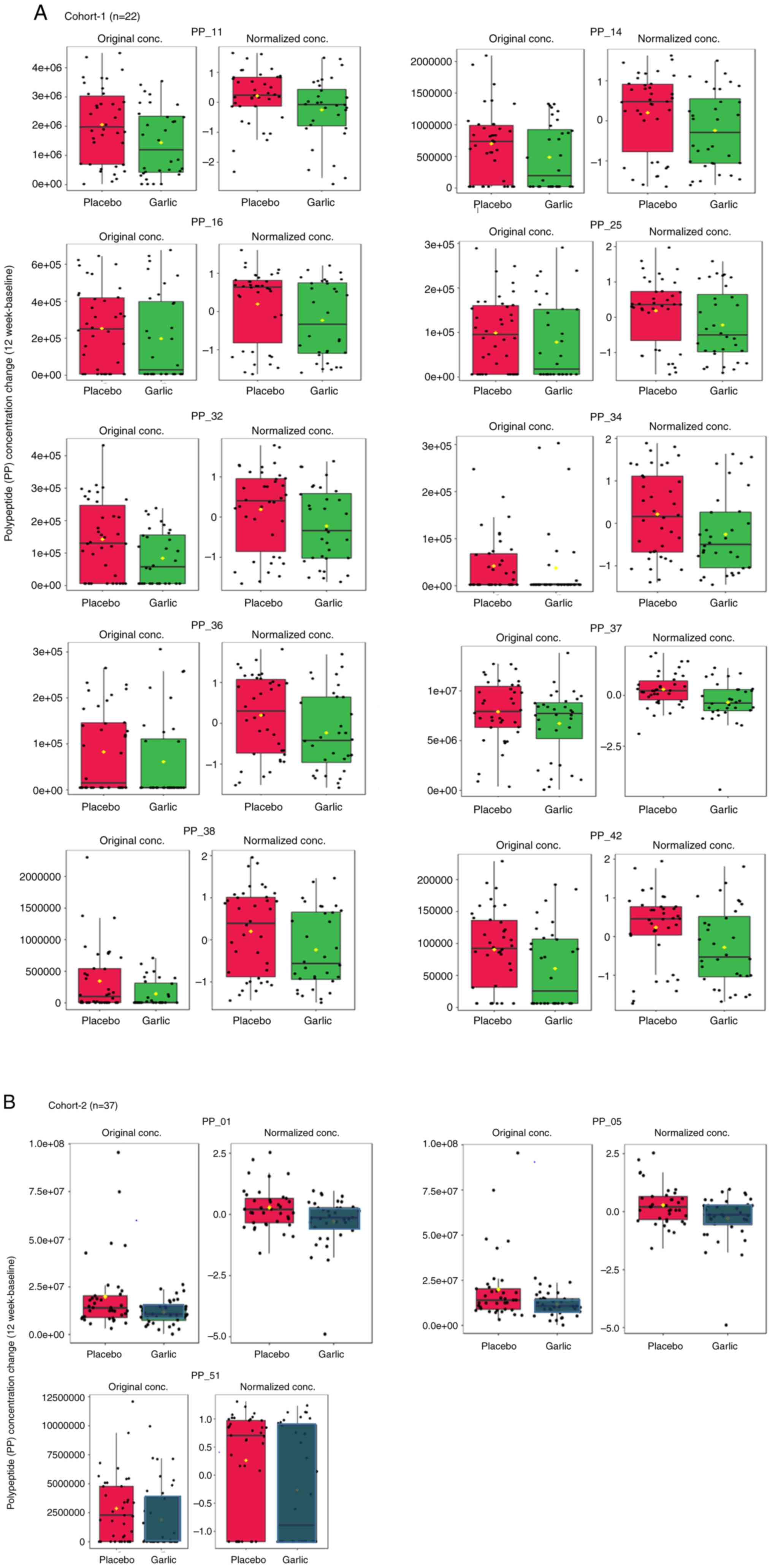Kyolic aged garlic extract improves aerobic fitness in middle‑aged recreational endurance athletes: A randomized double‑blind placebo‑controlled 3 month trial
- Authors:
- Published online on: February 26, 2025 https://doi.org/10.3892/etm.2025.12836
- Article Number: 86
-
Copyright: © Ried et al. This is an open access article distributed under the terms of Creative Commons Attribution License.
Abstract
Introduction
Previous studies have reported that Kyolic aged garlic extract improves cardiovascular function, including peripheral and central blood pressure, central pulse pressure and arterial stiffness, assessed using pulse wave velocity (PWV) in adults with elevated PWV levels (1-5). Central hemodynamic measures and arterial stiffness are regarded as more important predictors than peripheral blood pressure for cardiovascular disease, as concluded by expert consensus (6). The ability of an artery to expand and contract in response to blood pressure changes may decrease as a result of arterial stiffness (7). Arterial stiffness increases with age by 1.43 m/s every 10 years (8). This hardening of the blood vessel wall occurs as a result of age-related structural changes, including vascular calcification and the loss of elastin and collagen fibers in the arterial wall and atherosclerosis (9). The consequence of this reduced compliance is an increase in PWV, a method used for the assessment of arterial stiffness (6,10). PWV is measured non-invasively either directly by carotid-to-femoral aortic tonometry using the SphygmoCor device (Cardiex) (11) or indirectly by brachial pulse wave analysis with a computerized algorithm using the Mobil-O-Graph device with a blood pressure cuff (IEM GmbH) (12). The Mobil-O-Graph's computerized algorithm is based on age and gender adjusted population references values (13) and has been validated against the gold standard tonometry for PWV (14).
Exercise is considered one of the most effective approaches for the treatment and management of cardiovascular disease (15,16). The amount of exercise an individual is able to perform is dependent on their aerobic capacity and exercise tolerance (17). Aerobic capacity is limited by the ability of the cardiovascular system to deliver oxygen to the working musculature (18). In addition to aerobic capacity, lactate threshold, defined as the exercise intensity at which blood lactate concentrations accumulate faster than they can be removed, also decreases with age (19). However, the lactate threshold does not appear to change with age when expressed relative to percentage of volume-maximal-oxygen-consumption (VO2max) (20).
An increased VO2max results in an increased tolerance and ability to exercise and is reflected by lower levels of exertion and a later onset of blood lactate accumulation and reflects both the effect of the metabolic activity and the economy of the movement. An individual's lactate threshold represents applied aerobic power and aerobic capacity, which is considered the single biggest driver of success in endurance events (21). The concentration of blood lactate levels is used to objectively monitor exercise intensity during resistance and dynamic exercise (22). Delayed muscle soreness and prolonged recovery can be assessed using the 10 point Likert Pain Scale (23).
Aerobic capacity, measured by VO2max during moderate to high intensity exercise, is inversely related to arterial stiffness (24). Age-related decline in aerobic capacity and lactate threshold leads to reduced endurance performance (19,25). Measures of aerobic capacity, including VO2max, defined by maximal stroke volume (ml/beat), as well as heart rate (beats/min) and arterio-venous O2 (ml/100 ml) decline with age (19). Additionally, the age-related decline in VO2max is independent of the expected age-related decline in muscle mass (26). The arteries stiffen with age and lead to an increase in aortic input impedance as well as vascular afterload, thereby impeding the ejection of blood from the left ventricle during systole and consequently reducing stroke volume during exercise (19).
Animal studies suggest garlic supplements could ameliorate physical fatigue and increase exercise tolerance and oxygen uptake (27-29). Additionally, a number of human clinical studies have reported that garlic supplements improve aerobic capacity, in both an acute (5 h) (30,31) and a sub-chronic (6 week) setting (32). The cross-sectional study by Ince et al (30), involving 10 male athletes, reported that 900 mg of garlic powder ingested 5 h before high intensity exercise significantly improved VO2max. Another previously published cross-sectional study by Womack et al (31), involving 18 fit males, also reported that 900 mg of garlic powder ingested 3 h prior to high intensity exercise significantly improved VO2max. A 6 week trial testing the effect of garlic oil on cardiac performance and exercise tolerance in 30 patients with coronary artery disease found garlic to significantly reduce the heart rate at peak exercise and significantly reduce the work load upon the heart, resulting in improved exercise tolerance (32). Increased arterial stiffness may be a contributor to sudden cardiac events in otherwise physically fit middle-aged endurance athletes. In Melbourne alone in the previous 10 years, 2 middle-aged (55-65 years) male masters open water swimmers died due to an unexpected cardiac arrest during races (33,34).
Recent advances in the study of cardiovascular biomarkers include proteomics analysis. A urinary proteomics panel has been shown to predict endpoints associated with cardiovascular disease and cardiac events, including heart attack and stroke, in asymptomatic patients independent of age and sex (35-37). The validated proteomic profile consists of a panel of 25 urinary polypeptide markers, which show significant differences between patients who had a cardiac event and controls, making these polypeptides useful biomarkers for risk assessment of future cardiac events (36). In addition, a study assessing the intake of 20 ml olive oil daily for 6 weeks demonstrated statistically significant changes in cardiovascular risk proteomic urinary biomarkers compared with the baseline (38).
The present study aimed to assess the effect of Kyolic aged garlic extract on arterial stiffness, aerobic capacity, lactate threshold, muscle soreness, recovery time and urinary proteomic biomarkers associated with cardiovascular risk in a cohort of middle-aged recreational endurance athletes.
Materials and methods
Trial design and participants
Individuals were recruited at the National Institute of Integrative Medicine (NIIM; Melbourne, Australia) between October 2020-February 2024. Recreational endurance athletes (aged 40-65 years) were invited to participate in the present double-blind parallel randomized placebo-controlled dose-response trial of 12 weeks duration investigating the effect of Kyolic aged garlic extract on arterial stiffness and aerobic fitness during high intensity exercise on a cycle ergometer. Recreational endurance athletes were defined as regularly undertaking ≥3 30 min/week moderate to high intensity exercise sessions, such as triathlon, cycling, running or swimming.
The American Heart Association defines moderate exercise intensity at 50-70% of the maximum heart rate and vigorous/high exercise intensity at 70-85% of the maximum heart rate (39). Individuals were recruited through local fitness and masters cycling clubs, the NIIM newsletter and NIIM social media.
Individuals were excluded from the study if they were diagnosed with a cardiovascular condition, including a previous heart attack or stroke, or had a chronic illness, such as cancer. Additionally, individuals were also excluded if they had a recent surgery or were planning any surgery or change in medications, were pregnant during study or reported an intolerance to garlic.
Participants were instructed to cease any garlic supplementation prior to enrolment, and not to change their exercise routine or diet during the 3 month trial. As Kyolic aged garlic extract is consumed as a supplement with distinctly different therapeutic effects compared with raw or cooked garlic, the dietary intake of garlic was allowed to remain unchanged.
Participant allocation and trial supplements
The study was conducted in two parts, the first cohort was recruited between October 2020 and January 2022 and the second cohort was recruited between January 2023 and February 2024. Consenting eligible participants in the first cohort were randomly allocated to the low dose consisting of two capsules of aged garlic extract [Kyolic® Reserve Formula (Wakunaga of America, Co., Ltd.,) containing 1.2 g AGE powder and 1.2 mg S-allylcysteine (SAC)] or placebo (containing inert microcrystalline cellulose) daily for 12 weeks. In the second cohort participants were randomly allocated to the high dose consisting of four capsules of aged garlic extract (Kyolic® Reserve Formula containing 2.4 g AGE powder and 2.4 mg SAC) or placebo taken daily for 12 weeks. A computer-generated permuted random number table provided by an independent researcher not involved in recruitment, data collection or follow-up for the present study was used for randomization.
Kyolic aged garlic extract powder was manufactured from organically grown garlic bulbs, which have undergone a 20 month natural ageing process at room temperature. Placebo capsules were matched in appearance to the opaque active capsules and packaged in identical containers by the manufacturers off-site. Activated carbo-sachets were added to each container to disguise any odor. Participants, investigators and researchers were blinded to treatment allocation. Blinding success was assessed at the end of the trial by questionnaire.
Participants were instructed to start taking their trial capsules with food to minimize belching after the first VO2max testing session at baseline. Compliance was assessed by questionnaire and by capsule count throughout the study.
Assessments
Participants had four monthly appointments at NIIM (weeks 0, 4, 8 and 12), and two appointments at the Mets Performance exercise physiologist center (Melbourne, Australia) for testing of aerobic capacity with VO2max on a cycle ergometer, both at the beginning (week 0) and at the end of the study (week 12).
Baseline demographics
Participants' age, sex, BMI, regular medication and supplement intake and exercise routines were collected at baseline.
Exercise routines
The participants' exercise routines were assessed using an online questionnaire adapted from the International Physical Assessment Questionnaire (40) to quantify the length of regular moderate and high intensity exercises throughout the week.
Arterial stiffness, pulse wave velocity (PWV) and blood pressure
Arterial stiffness was assessed by non-invasive validated methods measuring PWV (41) using the SphygmoCor Xcel (Cardiex) (11) in cohort 1 and the Mobil-O-Graph device (IEM GmbH) (12) in cohort 2, due to the SphygmoCor Xcel no longer being supported in Australia from 2023. The Mobil-O-Graph has been validated against the gold standard tonometry for central blood pressure (14) and pulse wave analysis (42). However, PWV measurements are not directly comparable, whereby the Mobil-O-graph measured consistently lower PWV values compared with the SphygmoCor tonometer (43), therefore the PWV was presented separately for each cohort. The SphygmoCor Xcel (11) measures PWV directly by tonometry from carotid to femoral artery, while the patient is in a supine position. The Mobil-O-Graph (12) is a non-invasive device measuring central hemodynamic measures via a blood pressure cuff, such as blood pressure, pulse pressure, heart rate and PWV, an indicator for arterial stiffness. PWV is the speed in which the blood travels through the arteries in m/sec and is derived from the brachial pulse and indirectly calculated by a computerized algorithm and compared with age- and sex-adjusted population references values.
Participants were advised to refrain from drinking coffee or having a large meal for at least 2 h prior to the measurements and after at least 5 min of rest. Blood pressure was taken using a calibrated and validated digital sphygmomanometer (Omron HEM-907; Omron Healthcare Singapore Pte Ltd) (44).
Aerobic fitness, capacity, VO2max and lactate threshold
Aerobic fitness was measured by VO2max and aerobic and anaerobic/lactate threshold during high-intensity exercise using a cycle ergometer test station. The cyclist was connected to an oxygen analyzer, which measured the ratio of CO2 to the volume of oxygen intake. Blood lactate concentration was measured using a finger prick throughout the exercise workout.
VO2 max is defined as the maximum amount of oxygen your body can take in, transport via the blood stream into the muscles and utilize in 1 min.
Relative VO2 max (ml/kg/min) measures the maximum amount of oxygen that an individual can utilize during intense or maximal exercise, in ml/kg body weight/min. Absolute VO2 max (ml/min) is the total volume of oxygen regardless of body weight and is important for non-weight bearing activities such as swimming and flat cycling.
Cycle ergometer test procedure and bike protocol
The exercise workloads were selected to gradually progress in increments from moderate to maximal intensity. In the present study workload in increments of 30 Watts of power was increased every 3 min, starting at 60 Watts (Fig. 1A).
Aerobic and anaerobic lactate threshold
When exercising, energy is first produced aerobically by using oxygen and primarily by burning fat and carbohydrates, such as glucose. The aerobic threshold is reached when the production of energy starts to become dominated by anaerobic glycolysis (sugars) rather than the oxidation (aerobic in nature) of fats. Anaerobic energy production without oxygen produces lactate or lactic acid, and the lactate threshold is defined as the level of exercise intensity causing lactate to accumulate in the blood at a faster rate than it can be removed (Fig. 1B).
The lactate threshold test consisted of multiple blood lactate concentration measurements by a finger prick at the immediate completion of each incremental workload (30 Watts) during the cycling test, which was conducted until the participant's maximal intensity was reached. The lactate threshold occurs at a percentage of an athlete's VO2max based on their training status. In untrained individuals the lactate threshold is reached at ~50-60% of VO2max and in trained individuals at ~70-80% of VO2max. A higher lactate threshold correlates to better overall athletic performance.
Recovery time and muscle soreness and pain
Recovery time was assessed in days by a simple questionnaire, and muscle soreness by a pain 10-point Likert scale at baseline and at 12 weeks.
Proteomics
Urinary proteomic analysis was carried out by the Commonwealth Scientific and Industrial Research Organisation Land and Water following the protocol published by Zimmerli et al (35), featuring a panel of 22 cardiovascular risk-relevant peptides using high-resolution liquid chromatography-mass spectrometry (LC-MS). Proteins (>3 KDa) were removed from urine samples using Amicon Centrifugal Filter Units at 16,100 x g at room temperature for 5-10 min using an Eppendorf centrifuge. Urine samples were normalized to the measured creatinine concentration and urine samples were dried in a speed-Vac. Sample pellets were resuspended in 40 ul of 0.1% formic acid in preparation for LC-MS analysis and 5 ul was injected onto the LC-MS for analysis. Samples were desalted and concentrated with a trap column (PepMap100 C18 5 mm x 300 µm, 5 µm, Thermo Scientific. Inc.) and separated on a nano column (PepMap100 C18 150 mm x 75 µm, 2 µm, Thermo Scientific. Inc.) using an UltimateTM 3000 RSLC nano LC system (Thermo Scientific. Inc.). Flow rate was 300 nl/min and system temperature was 35˚C. Mobile phase A consisted of water and 0.1% (v/v) formic acid and mobile phase B consisted of 80% (v/v) acetonitrile and 0.08% (v/v) formic acid. Urine peptides were eluted using a gradient of 5 to 60% solvent B for 20 min and 60 to 99% solvent B for 7 min. The eluted peptides were ionized with a Nanospray Flex Ion Source (Thermo Scientific. Inc.). The spray voltage was set to 2.3 kV and the temperature of the heated capillary was set at 300˚C. Sweep nitrogen gas flow rate was at 1.5l/min and source pressure was at 1.48 Torr. After ionization, mass spectra (MS1) and tandem mass spectra (MS/MS) analysis was performed using an Orbitrap Fusion MS (Thermo Scientific. Inc.). MS survey scans of peptide precursors were performed in the Orbitrap detector and the scan range was 400 to 1500 m/z at resolution of 120 K (at 200 m/z). The target value of automatic gain control (AGC) was set as 4 x 105. The maximum injection time for the MS was 50 ms. MS/MS was performed on the most abundant precursors of charge states 2+ to 7+ with intensity greater than 1 x 105. They were isolated by the quadrupole with a window of 1.6 m/z. Fragmentation was achieved by high-energy collisional dissociation (HCD) with collision energy of 28%. Fragments were detected in the ion trap detector in rapid scan rate mode. The AGC target was 4 x 103, maximum injection time was 300 ms and the dynamic exclusion was 15 sec. The instrument was set to run in top speed mode with a three sec cycle for both the MS and MS/MS scans.
A list of 81 urinary peptides identified by Brown et al (36) was used to search peptides in the urine samples. Precursor mass tolerance was set to 10 ppm and product ions were searched at 0.6 Da. No-Enzyme (unspecific) was selected. Modification included Oxidation (+15.995 Da). Creatinine, a clearance protein, was measured to adjust for differences in urinary concentration between patients due to hydration variances. Urine creatinine concentration was measured using an ELISA-based assay using a Creatinine Urinary Detection Kit (cat. no. EIASCR; Invitrogen; Thermo Fisher Scientific, Inc.) and measured using a UV-Vis spectrometer at a wavelength of 490 nm. Each urine sample was diluted 1:20 and 50 µl was used for the assay as per the manufacturer's protocol.
Statistical analysis
Primary outcome measures were aerobic fitness, including VO2max, aerobic and lactate threshold and power. Secondary outcome measures were recovery time, muscle soreness, PWV and proteomic biomarkers. Analyses were performed using SPSS Inc. (version 26; IBM Corp.). P<0.05 was considered to indicate a statistically significant difference.
Differences between groups at baseline were assessed by χ2 test or Fisher's Exact test if the values were <5 for categorical variables and by an unpaired Student's t-test for continuous variables.
The participant's mean change score (value at 12 weeks- value at baseline) was calculated for each outcome measure and ANCOVA with Bonferroni's correction was performed. Relevant baseline values were used as co-variates to assess the mean differences between groups (garlic vs. placebo).
For the main statistical analyses, cohort 1 and cohort 2 were combined (low and high dose), and subgroup analysis was performed by cohort.
Polypeptide data were normalized to creatinine clearance protein. Missing values were replaced by one-fifth of the minimum positive values of their corresponding variables. The acquired data were then log10 transformed and scaled using the mean-centred value and divided by the SD of each variable. Data were then subjected to univariate and multivariate statistical analysis using SIMCA (version 17.01; Sartorius Stedim Biotech; Sartorius AG). GraphPad Prism (version 9.3.0; Dotmatics) was used for descriptive statistical analysis and plot generation.
A 15 peptide quality assurance and quality control (QAQC) standard consisting of 15 heavy isotope-labelled peptides (cat number 88321; Thermo Fisher Scientific, Inc.) was analysed throughout the analytical sequence and was found to be with a 5% relative standard deviation, demonstrating good analytical performance of the column and MS detector.
Results
Participants
The trial was conducted in two parts whereby the first cohort, allocated the low trial supplement dose, was recruited between October 2020 and January 2022 during the COVID-19 lockdowns and the second cohort, allocated the high trial supplement dose, was recruited between January 2023 and February 2024.
A total of 108 potential participants were screened for eligibility, with a total of 24 either not fitting inclusion criteria (n=18) or losing interest shortly after enrollment into the study (n=6). Of the potential participants, one was not eligible on medical grounds due to a high PWV reading at screening prompting a consultation with a cardiologist and a subsequent diagnosis of severe coronary artery disease, despite not having any other risk factors such as hypertension or high cholesterol. A further nine participants withdrew after baseline VO2max testing, either due to losing interest in the study (n=4), the long travel distance to and from the study site (n=2), COVID-19 lockdown (n=1), study-unrelated gastroenteritis (n=1) or medical advice from the patient's doctor (n=1). In total, 75 participants completed the study, including 37/40 (92%, cohort-1) and 38/40 (95%, cohort-2). The mean age was 53±8 years and two-thirds of the participants were male (Table I).
All participants in the first cohort were serious endurance athletes who trained an average of 1.5 h daily with moderate to high intensity exercise (~1 h moderate and ~30 min high intensity) of either cycling, running or swimming. The majority (86%) of participants in cohort-1 were cyclists, cycling up to 400 km or 17 h per week (Table II).
The second cohort was significantly less athletic overall compared with the first cohort, training an average of 45 min daily of moderate to high intensity exercise (~30 min moderate and ~15 min high intensity) (Table II). Participants in cohort-2 exercised through a variety of sports including cycling, running, rowing, swimming, kick boxing, Bikram hot yoga and underwater hockey (Table II, Fig. 2).
Blood pressure and PWV
At baseline there were no statistical differences in blood pressure or PWV between the garlic vs. placebo groups. However, at the end of the study, a marked improvement in blood pressure and PWV was observed in the Kyolic group compared with the placebo group in a subgroup of participants with elevated blood pressure (>135 mmHg SBP), as well as in PWV (Table III).
Primary outcome measures of aerobic fitness, VO2max, lactate threshold and power
Kyolic aged garlic extract significantly improved aerobic fitness, as evidenced by increased absolute VO2max (mean difference, 133±83 ml/min; P<0.07), power (mean difference, 10.2±4.9 W; P<0.04), lactate threshold to power output (mean difference, 11.8±3.2 W; P<0.001), lactate threshold to oxygen uptake (mean difference, 174±72 ml/min; P<0.02) and aerobic threshold to power output (mean difference, 9.1±4.5 W; P<0.045) (Table IV, Figs. 3 and 4).
Comparison of baseline aerobic fitness between low dose and high dose cohorts
While there were no significant differences between the garlic and the placebo groups in participants' types of sports (Table II, Fig. 2), there were differences in exercise regimes and fitness levels between the first cohort (low dose) and the second cohort (high dose) at baseline. While the first cohort exercised a mean of ~90 min/day (54 min of moderate intensity and 40 min of high intensity/day), the second cohort exercised a mean of 45 min/day (30 min moderate and 15 min high intensity/day), which was approximately one-half of the time exercising and at a lower intensity compared with the first cohort (Table V).
As the baseline levels of certain aerobic fitness measurements, such as VO2max, were significantly different between the two cohorts (low dose vs. high dose, P<0.001), a dose-response analysis was not feasible (Table V). The baseline fitness of the two cohorts would have influenced or confounded any dose-dependent outcome measures. However, in both cohorts, the Kyolic group had statistically significant improvements in aerobic fitness compared with the placebo group (Table SI).
Compared with cohort 2, aerobic capacity improved significantly in cohort 1, as evidenced by increased absolute VO2max (mean difference, 238±105 ml/min; P<0.03), power (mean difference, 16.2±7.3 W; P<0.035), lactate threshold to power output (mean difference, 16.9±5.4 W; P<0.003), lactate threshold to oxygen uptake (mean difference, 269±104 ml/min; P<0.014) and aerobic threshold to oxygen uptake (mean difference, 245±90 ml/min; P<0.01; Table SI).
Recovery time and muscle soreness
Kyolic aged garlic extract significantly improved aerobic fitness, as evidenced by quicker recovery times compared with the placebo group in both treatment cohorts combined (n=70; mean difference, -0.6±0.3 days; P<0.05) (Table VI, Fig. 5). Additionally, the difference in the recovery time was more pronounced in the cohort 1 (low dose), with the garlic-treated group recovering significantly quicker compared with the placebo group after exercise (mean difference, -1.1±0.5 days; P<0.025) (Table VI). Muscle soreness was reduced in both groups compared with baseline (albeit not significantly; Fig. 6).
Cardiovascular risk-related proteomic urinary biomarkers
In a subgroup of participants from the first cohort (n=22) and the second cohort (n=37), a panel of 22 polypeptides and their derivates were tested. As higher concentrations of these polypeptides have been associated with higher cardiovascular risk, a reduction in the levels of these polypeptides is desirable. It was demonstrated that a subset of polypeptides significantly decreased in the Kyolic group compared with the placebo group, leading to an improved cardiovascular risk proteomic profile in the Kyolic group at the end of the study (Table VII, Fig. 7). Proteomic analysis differed between the cohorts. In the low dose cohort, 10/22 (45%) of the peptide concentrations were significantly reduced in the Kyolic group compared with the placebo (Fig. 7a) and 3/22 (13%) were significantly reduced in the second cohort (Fig. 7b). Furthermore, the mean polypeptide baseline levels varied between the cohorts. Therefore, a combined proteomic analysis of both cohorts was not statistically meaningful.
Table VIIList of PPs with significant differences in PP concentration change between the garlic group compared with the placebo group. |
Compliance, tolerability and blinding
Compliance was satisfactory, with all participants taking their trial supplements >95% according to protocol.
Tolerability was high, with 1 participant in the placebo group noting a weight gain of 2-3 kg over the course of the study and 1 participant in the garlic group noting a lower heart rate. In the garlic group, 1 participant reported burping, which did not bother her and another participant noted that her menstrual cycle improved becoming more regular and less painful.
Blinding was successful in both cohorts. In the low dose cohort 1, the majority (80%) were unsure of their group allocation, while 5% guessed their group allocation incorrectly, verifying successful blinding. In the high dose cohort 2, a greater proportion guessed correctly (37%) compared with the low dose cohort 1 (16%) and two-thirds (63%) were unsure or incorrect (Table VIII).
Discussion
The results of the study demonstrated that Kyolic aged garlic extract significantly improved aerobic fitness in middle-aged endurance athletes within 12 weeks, as evidenced by the increased oxygen uptake, power, lactate threshold-to-power output, lactate threshold-to-oxygen uptake, and quicker recovery times observed when compared with the placebo group. Furthermore, arterial flexibility, assessed by PWV, improved more in the Kyolic aged garlic group compared with the placebo group. These results are in line with previous animal (27-29) and human studies (30-32), whereby garlic supplements ingested for an acute or sub-chronic period significantly ameliorated physical fatigue, increased exercise tolerance and increased oxygen uptake, resulting in overall higher aerobic capacity.
A number of human studies involving 10(30) or 18(31) male athletes investigated the acute effect of garlic on aerobic capacity and found that 900 mg of garlic powder ingested 3 or 5 h, respectively, before high intensity exercise significantly improved the VO2max. A 6 week trial testing the effect of garlic oil on cardiac performance and exercise tolerance in 30 patients with coronary artery disease reported that garlic oil significantly reduced heart rate at peak exercise, leading to improved exercise tolerance (32).
In addition, the present study demonstrated that Kyolic aged garlic extract improved the cardiovascular risk proteomic biomarker profile compared with the placebo group, which was in line with previously published results (35,38). Lower concentrations of a panel of 25 urinary polypeptides/protein biomarkers (35) have been associated with reduced cardiovascular risk, such as heart attack and stroke, independent of age and sex in asymptomatic patients (36,37). The present study demonstrated that Kyolic aged garlic extract was effective at significantly lowering the concentrations of a subset of the aforementioned biomarkers compared with the placebo group after 3 months of supplementation. Therefore, the present study adds to previous research demonstrating that diet and exercise are effective in improving the proteomic cardiovascular risk profile. A study involving 69 healthy participants showed that olive oil ingested daily over 6 weeks significantly improved certain cardiovascular risk proteomic biomarkers compared with the baseline (38). Additionally, exercise reduced the cardiovascular risk proteomic profile in a cohort of 88 patients with coronary artery disease, while there was no change in the inactive patients (35).
The present study had several strengths, involving a reasonable sample size of 75 middle-aged endurance athletes completing the trial with high compliance and having access to specialized equipment and the expertise of professional exercise physiologists for objective and accurate measures of the primary outcome variables related to aerobic fitness. Furthermore, the findings of the effect of Kyolic aged garlic extract compared with placebo were comparable in both athletically diverse cohorts, while more pronounced within in the fitter cohort 1, suggesting that Kyolic aged garlic extract may be effective in improving aerobic capacity independent of baseline aerobic fitness.
However, the athletic disparity between the two cohorts limited the opportunity for a meaningful comparative dose-response analysis. The more athletic cohort 1 (low dose Kyolic aged garlic extract) exercised a mean of 1.5 hours/day at a moderate to high intensity and had significantly greater aerobic fitness at baseline, compared with cohort 2 (high dose Kyolic aged garlic extract) who exercised a mean of 45 min/day. The differences in aerobic fitness between the cohorts at baseline were significantly greater when compared with any changes caused by the treatment intervention within each cohort, confounding any meaningful comparative analysis by dose. Future studies could plan recruitment for both Kyolic aged garlic extract doses within a shorter time period, perhaps using a block randomization of alternating 10 low dose/10 high dose interventions, which increases the likelihood of drawing participants who have a similar level of athleticism. A further limitation in this study concerned the assessment of arterial stiffness, as PWV was measured using different devices in each cohort. Due to unforeseen circumstances, the SphygmoCor tonometer (11) used to measure PWV in cohort 1 was no longer serviced in Australia during the cohort 2 study period, therefore, the Mobil-O-graph device (12) was used for cohort 2. While both devices have been validated against the gold standard tonometry for central blood pressure (14) and pulse wave analysis (42), PWV measurements taken with different devices have been shown not to be directly comparable (43). Therefore, the present analysis could not combine the measurements from both cohorts, reducing the statistical power due to the smaller sample size. This also impacted the hypothesis that more flexible arteries, assessed by PWV, would improve aerobic fitness due to increased oxygen uptake, as this could not be measured. A further limitation was the assessment of recovery time in days by a simple questionnaire which was administered on a monthly basis. To improve precision and reduce subjectivity, future studies could use an online daily or weekly diary assessing the recovery in hours rather than days (e.g. 36 hours vs. 1 or 2 days). Additionally, a combined proteomic analysis of both cohorts was confounded by the baseline differences in polypeptide levels between the cohorts. In cohort 1, 45% of the polypeptides tested were significantly reduced in the Kyolic aged garlic extract group compared with the placebo, whereas 13% of the polypeptides were significantly reduced in the cohort 2. Further research should be conducted to explore the factors that caused the difference in proteomic and metabolomic profiles at baseline in endurance athletes with different aerobic fitness levels. Furthermore, longer-term studies are needed to explore the sustained effect of Kyolic aged garlic extract on aerobic fitness and associated cardiovascular morbidity and mortality.
The present study demonstrated that Kyolic aged garlic extract significantly improved aerobic fitness within 12 weeks in middle-aged endurance athletes, as evidenced by increased VO2max, increased lactate threshold, quicker recovery and improved cardiovascular risk proteomic profile. Furthermore, these findings are in line with previous research providing evidence that Kyolic aged garlic extract reduces arterial stiffness, a process that occurs with age. An increase in arterial flexibility is associated with slower blood flow, which in turn improves oxygen uptake, reduces lactate production and muscle soreness linked to recovery and improves overall aerobic fitness. While previous research with Kyolic aged garlic extract focused on comparatively ‘unhealthy’ populations with cardiovascular risk factors such as hypertension, the present study provided evidence for the use of Kyolic aged garlic extract to benefit a ‘healthier’ middle-aged population.
Supplementary Material
Aerobic capacity of cohortsa,b.
Acknowledgements
The authors are grateful to the exercise physiologists from Mets Performance who conducted the aerobic fitness testing, including VO2max testing and lactate analysis of the study participants using a cycle ergometer. The abstract was presented at the 2024 International Garlic Symposium in Munich, Germany (45). The authors would like to acknowledge Olympian cyclist Kathy Watt, OAM, who assisted with recruitment of the endurance cyclists in the present study.
Funding
Funding: KR received a travel sponsorship from Wakunaga of America Co., Ltd. to attend the 2024 International Garlic Symposium in Munich, Germany. The present trial was supported by a grant from Wakunaga of America Co., Ltd. who supplied trial capsules and provided funding for the costs of tests, research assistance and open access publication. The sponsor was not involved in study design, data collection, analysis or preparation of the manuscript.
Availability of data and materials
The data generated in the present study may be found in the Commonwealth Scientific and Industrial Research Organisation Data Access portal at the following URL: https://data.csiro.au/collection/csiro:64384.
Authors' contributions
KR and AS conceptualised the study, KR acquired funding and oversaw data collection and data entry conducted by YP. DB undertook proteomics data analysis and uploaded the raw data to a public database. KR undertook data analysis and prepared the manuscript with contributions from co-authors. YP and KR confirm the authenticity of all the raw data, with DB's input of raw proteomics data. All authors approved the final version of the manuscript.
Ethics approval and consent to participate
The present study was approved by the National Institute of Integrative Medicine Human Research Ethics Committee EC00436 (approval no. 0062N_2020; Melbourne, Australia) and written informed consent was obtained from each individual for participation in the study.
Patient consent for publication
Not applicable.
Competing interests
The authors declare that they have no competing interests.
References
|
Ried K and Fakler P: Potential of garlic (Allium sativum) in lowering high blood pressure: mechanisms of action and clinical relevance. Integr Blood Press Control. 7:71–82. 2024.PubMed/NCBI View Article : Google Scholar | |
|
Ried K, Frank OR and Stocks NP: Aged garlic extract lowers blood pressure in patients with treated but uncontrolled hypertension: A randomised controlled trial. Maturitas. 67:144–150. 2010.PubMed/NCBI View Article : Google Scholar | |
|
Ried K, Frank OR and Stocks NP: Aged garlic extract reduces blood pressure in hypertensives: a dose-response trial. Eur J Clin Nutr. 67:64–70. 2013.PubMed/NCBI View Article : Google Scholar | |
|
Ried K, Travica N and Sali A: The effect of aged garlic extract on blood pressure and other cardiovascular risk factors in uncontrolled hypertensives: the AGE at Heart trial. Integr Blood Press Control. 9:9–21. 2016.PubMed/NCBI View Article : Google Scholar | |
|
Ried K, Travica N and Sali A: The effect of Kyolic aged garlic extract on gut microbiota, inflammation and cardiovascular health in hypertensives: The GarGIC trial. Frontiers in Nutrition. 5(122)2018.PubMed/NCBI View Article : Google Scholar | |
|
Laurent S, Cockcroft J, Van Bortel L, Boutouyrie P, Giannattasio C, Hayoz D, Pannier B, Vlachopoulos C, Wilkinson I and Struijker-Boudier H: European Network for Non-invasive Investigation of Large Arteries. Expert consensus document on arterial stiffness: methodological issues and clinical applications. Eur Heart J. 27:2588–2605. 2006.PubMed/NCBI View Article : Google Scholar | |
|
Zieman SJ, Melenovsky V and Kass DA: Mechanisms, pathophysiology, and therapy of arterial stiffness. Arterioscler Thromb Vasc Biol. 25:932–943. 2005.PubMed/NCBI View Article : Google Scholar | |
|
Nunan D, Fleming S, Hametner B and Wassertheurer S: Performance of pulse wave velocity measured using a brachial cuff in a community setting. Blood Pressure Monitoring. 19:315–319. 2014.PubMed/NCBI View Article : Google Scholar | |
|
Lee HY and Oh BH: Aging and arterial stiffness. Circ J. 74:2257–2262. 2010.PubMed/NCBI View Article : Google Scholar | |
|
Luft FC: Molecular mechanisms of arterial stiffness: New insights. J Am Soc Hypertens. 6:436–438. 2012.PubMed/NCBI View Article : Google Scholar | |
|
SphygmoCor XCEL, Cardiex USA. Available from: https://cardiex.com/products/sphygmocor-xcel/. | |
|
Mobil-O-Graph IEM, Germany. Available from: https://www.iem.de/en_US/mobil-o-graph. | |
|
Nunan D, Wassertheurer S, Lasserson D, Hametner B, Fleming S, Ward A and Heneghan C: Assessment of central haemomodynamics from a brachial cuff in a community setting. BMC Cardiovasc Disord. 12(48)2012.PubMed/NCBI View Article : Google Scholar | |
|
Weiss W, Gohlisch C, Harsch-Gladisch C, Tölle M, Zidek W and van der Giet M: Oscillometric estimation of central blood pressure: validation of the Mobil-O-Graph in comparison with the SphygmoCor device. Blood Press Monit. 17:128–131. 2012.PubMed/NCBI View Article : Google Scholar | |
|
Naci H and Ioannidis JP: Comparative effectiveness of exercise and drug interventions on mortality outcomes: Metaepidemiological study. Br J Sports Med. 49:1414–1422. 2015.PubMed/NCBI View Article : Google Scholar | |
|
Fagard RH: Exercise therapy in hypertensive cardiovascular disease. Prog Cardiovasc Dis. 53:404–411. 2011.PubMed/NCBI View Article : Google Scholar | |
|
Myers J, Gullestad L, Bellin D, Ross H, Vagelos R and Fowler M: Physical activity patterns and exercise performance in cardiac transplant recipients. J Cardiopulm Rehabil. 23:100–106. 2003.PubMed/NCBI View Article : Google Scholar | |
|
Bassett DR and Howley ET: Limiting factors for maximum oxygen uptake and determinants of endurance performance. Med Sci Sports Exerc. 32:70–84. 2000.PubMed/NCBI View Article : Google Scholar | |
|
Tanaka H and Seals DR: Endurance exercise performance in Masters athletes: age associated changes and underlying physiological mechanisms. J Physiol. 586:55–63. 2008.PubMed/NCBI View Article : Google Scholar | |
|
Maffulli N, Testa V and Capasso G: Anaerobic threshold determination in master endurance runners. J Sports Med Phys Fitness. 34:242–249. 1994.PubMed/NCBI | |
|
Faude O, Kindermann W and Meyer T: Lactate threshold concepts. Sports Med. 39:469–490. 2009.PubMed/NCBI View Article : Google Scholar | |
|
Abe D, Yoshida T, Ueoka H, Sugiyama K and Fukuoka Y: Relationship between perceived exertion and blood lactate concentrations during incremental running test in young females. BMC Sports Sci Med Rehabil. 7(5)2015.PubMed/NCBI View Article : Google Scholar | |
|
McCormack HM, David JdL and Sheather S: Clinical applications of visual analogue scales: A critical review. Psychol Med. 18:1007–1019. 1988.PubMed/NCBI View Article : Google Scholar | |
|
Vaitkevicius PV, Fleg JL, Engel JH, O'Connor FC, Wright JG, Lakatta LE, Yin FC and Lakatta EG: Effects of age and aerobic capacity on arterial stiffness in healthy adults. Circulation. 88:1456–1462. 1993.PubMed/NCBI View Article : Google Scholar | |
|
Tanaka H and Seals DR: Invited review: Dynamic exercise performance in masters athletes: Insight into the effects of primary human aging on physiological functional capacity. J Applied Physiol. 95:2152–2162. 2003.PubMed/NCBI View Article : Google Scholar | |
|
Proctor DN and Joyner MJ: Skeletal muscle mass and the reduction of VO2max max in trained older subjects. J Appl Physiol. 82:1411–1415. 1997.PubMed/NCBI View Article : Google Scholar | |
|
Morihara N, Ushijima M, Kashimoto N, Sumioka I, Nishihama T, Hayama M and Takeda H: Aged garlic extract ameliorates physical fatigue. Biol Pharm Bull. 29:962–966. 2006.PubMed/NCBI View Article : Google Scholar | |
|
Morihara N, Nishihama T, Ushijima M, Ide N, Takeda H and Hayama M: Garlic as an anti-fatigue agent. Mol Nutr Food Res. 51:1329–1334. 2007.PubMed/NCBI View Article : Google Scholar | |
|
Ushijima M, Sumioka I, Kakimoto M, Yokoyama K, Uda N, Matsuura H, Kyo E, Suzuki A, Kasuga S, Itakura Y, et al: Effect of garlic and garlic preparations on physiological and psychological stress in mice. Phytotherapy Res. 11:226–230. 1997. | |
|
Ince D, Soenmez G and Ince M: Effects of garlic on aerobic performance. Turkish J Med Sci. 30:557–561. 2000. | |
|
Womack C, Lawton D, Redmond L, Todd M and Hargens T: The effects of acute garlic supplementation on the fibrinolytic and vasoreactive response to exercise. J Int Soc Sports Nutr. 12(23)2015.PubMed/NCBI View Article : Google Scholar | |
|
Verma SK, Rajeevan V, Jain P and Bordia A: Effect of garlic (Allium sativum) oil on exercise tolerance in patients with coronary artery disease. Indian J Physiol Pharmacol. 49:115–118. 2005.PubMed/NCBI | |
|
The-Age: Charles Erasmus, a ‘gentle soul’, loses life just metres from Big Bay Swim finish line. https://www.theage.com.au/national/victoria/charles-erasmus-a-gentle-soul-loses-life-just-metres-from-big-bay-swim-finish-line-20150223-13m3u0.html. | |
|
ABC-News: Man, 65, dies during Lorne's Pier to Pub open water swim, Victoria. https://www.abc.net.au/news/2019-01-12/man-drowns-during-pier-to-pub-open-water-swim-race/10711120. | |
|
Zimmerli LU, Schiffer E, Zürbig P, Good DM, Kellmann M, Mouls L, Pitt AR, Coon JJ, Schmieder RE, Peter KH, et al: Urinary proteomic biomarkers in coronary artery disease. Mol Cell Proteomics. 7:290–298. 2008.PubMed/NCBI View Article : Google Scholar | |
|
Brown CE, McCarthy NS, Hughes AD, Sever P, Stalmach A, Mullen W, Dominiczak AF, Sattar N, Mischak H, Thom S, et al: Urinary proteomic biomarkers to predict cardiovascular events. Proteomics Clin Appl. 9:610–617. 2015.PubMed/NCBI View Article : Google Scholar | |
|
Delles C, Schiffer E, von Zur Muhlen C, Peter K, Rossing P, Parving HH, Dymott JA, Neisius U, Zimmerli LU, et al: Urinary proteomic diagnosis of coronary artery disease: identification and clinical validation in 623 individuals. J Hypertens. 28:2316–2322. 2010.PubMed/NCBI View Article : Google Scholar | |
|
Silva S, Bronze MR, Figueira ME, Siwy J, Mischak H, Combet E and Mullen W: Impact of a 6-wk olive oil supplementation in healthy adults on urinary proteomic biomarkers of coronary artery disease, chronic kidney disease, and diabetes (types 1 and 2): A randomized, parallel, controlled, double-blind study. Am J Clin Nutr. 101:44–54. 2015.PubMed/NCBI View Article : Google Scholar | |
|
American-Heart-Association. Target Heart Rate Charts 2024. Available from: https://www.heart.org/en/healthy-living/fitness/fitness-basics/target-heart-rates. | |
|
Craig CL, Marshall AL, Sjöström M, Bauman AE, Booth ML, Ainsworth BE, Pratt M, Ekelund U, Yngve A, Sallis JF and Oja P: International physical activity questionnaire: 12-country reliability and validity. Med Sci Sports Exerc. 35:1381–1395. 2003.PubMed/NCBI View Article : Google Scholar | |
|
Salvi P, Scalise F, Rovina M, Moretti F, Salvi L, Grillo A, Gao L, Baldi C, Faini A, Furlanis G, et al: Noninvasive estimation of aortic stiffness through different approaches: comparison with intra-aortic recordings. Hypertension. 74:117–129. 2019.PubMed/NCBI View Article : Google Scholar | |
|
Wassertheurer S, Kropf J, Weber T, Van der Giet M, Baulmann J, Ammer M, Hametner B, Mayer CC, Eber B and Magometschnigg D: A new oscillometric method for pulse wave analysis: Comparison with a common tonometric method. J Hum Hypertens. 24:498–504. 2010.PubMed/NCBI View Article : Google Scholar | |
|
Kolkenbeck-Ruh A, Soepnel LM, Kim AW, Naidoo S, Smith W, Davies J and Ware LJ: Pulse wave velocity in South African women and children: comparison between the Mobil-O-Graph and SphygmoCor XCEL devices. J Hypertens. 40:65–75. 2022.PubMed/NCBI View Article : Google Scholar | |
|
Blood Pressure Monitor Omron HEM-907, JA-Davey-Pty-Ltd Australia. Available from: https://www.omronhealthcare-ap.com/au/product/93-hem-907. | |
|
Abstract 0-13, International Garlic Symposium. Frontiers of garlic research in health promotion and disease prevention. Munich, Germany, 26-28 April 2024. https://garlicsymposium2024.com. |



